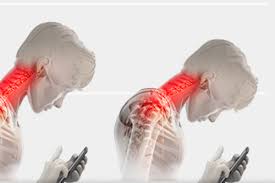

You have heard about how sitting all day can ruin your posture, but did you know that using a tablet can do just as much damage, if not more?
The phenomenon of “tech neck” is not limited to smartphones and laptops; tablets play a massive role in neck strain and upper back discomfort.
In this article, we shall break down how prolonged tablet use affects your neck muscles, why this happens, and what you can do about it.
Prepare to dive into the fascinating (and frustrating) mechanics of neck pain, with plenty of real-life examples to hammer home the point—pun intended!
In This Article:
- What Happens to Your Neck Muscles When Using a Tablet?
- Why Tablet Screen Position Worsens Neck Strain
- The Anatomy of Neck Pain: Muscles, Tendons, and Ligaments
- Real-Life Examples of Tablet-Induced Neck Issues
- How to Avoid Neck Strain While Using a Tablet
- Conclusion: Saving Your Neck, One Tablet Adjustment at a Time
What Happens to Your Neck Muscles When Using a Tablet?
Imagine this: You are catching up on the latest news, swiping through an e-book, or binge-watching a series on your tablet.
Your head tilts forward, and you’re leaning in for a better look.
What you do not realize is that your poor neck muscles are bearing the brunt of this posture.
According to a study published in Surgical Technology International by Dr. Kenneth Hansraj, tilting your head forward by just 15 degrees places about 27 pounds of pressure on your neck.
Increase that angle to 60 degrees (as many of us do when looking at a tablet placed on a low table or held in our lap), and you are exerting a whopping 60 pounds of pressure.
Yikes!
This constant pressure can lead to muscle fatigue, tension, and even long-term damage.
Why Tablet Screen Position Worsens Neck Strain?
Unlike a computer monitor that sits at eye level, tablets are typically held much lower, especially if they are resting in your lap or on a table.
This means that your neck is constantly craned downward.
The more time you spend looking down, the more your neck muscles have to work to hold your head up.
The Journal of Physical Therapy Science highlights that the forward head posture caused by low tablet positioning leads to the shortening of the muscles at the front of the neck and the overworking of the muscles at the back.
Over time, this imbalance contributes to chronic neck pain and tension headaches.
Consider Sarah, a graphic designer who uses her tablet for hours each day to sketch and create designs.
She started noticing a persistent ache in her neck and shoulders.
Her physical therapist explained that her habit of looking down at her tablet was causing the problem.
Once Sarah adjusted her setup and took more frequent breaks, the pain began to subside.
The Anatomy of Neck Pain: Muscles, Tendons, and Ligaments
Let’s delve into the intricate relationship between prolonged device usage and its impact on your neck’s anatomy.
Understanding the Cervical Spine and Associated Muscles
The cervical spine comprises seven vertebrae supported by a complex network of muscles, tendons, and ligaments. This structure facilitates head movement and provides stability. However, habitual forward head posture, such as looking down at a tablet for extended periods, can adversely affect specific muscles:
Trapezius Muscle: Extending along the upper back and neck, the trapezius is responsible for moving and stabilizing the shoulder blades. Forward head posture overworks shoulder muscle, leading to tension and discomfort.
Levator Scapulae: Connecting the cervical spine to the shoulder blades, this muscle assists in elevating the shoulders. Maintaining a downward gaze tightens the levator scapulae, resulting in stiffness and reduced range of motion.
Suboccipital Muscles: Located at the base of the skull, these small muscles facilitate head extension and rotation. Chronic forward tilting strains the suboccipital muscles, contributing to headaches and neck pain.
Consequences of Prolonged Forward Head Posture
Sustained forward head posture not only affects muscle integrity but also has broader implications:
Muscle Imbalance: Continuous forward tilting causes certain muscles to become overactive while others weaken, disrupting the natural muscle balance and leading to postural issues.
Reduced Respiratory Efficiency: Forward head posture can compromise respiratory function by weakening the respiratory muscles. Studies have shown that individuals with forward head posture may experience reduced forced vital capacity (FVC) and forced expiratory volume in 1 second (FEV1), indicating diminished respiratory efficiency.
Increased Cervical Spine Loading: The altered alignment increases stress on the cervical vertebrae and associated ligaments, potentially leading to degenerative disc disease.
Mitigating the Effects
To counteract the negative impacts of prolonged device usage on neck health:
Ergonomic Adjustments: Position screens at eye level to maintain a neutral head posture, reducing undue strain on cervical structures.
Regular Breaks and Exercises: Incorporate routine breaks to perform neck stretches and strengthening exercises, promoting muscle balance and flexibility.
Postural Awareness: Cultivate mindfulness of head and neck positioning throughout daily activities to prevent the development of habitual forward head posture.
By understanding and addressing the biomechanical effects of device usage on neck anatomy, one can take proactive steps to maintain cervical health and overall well-being.
Real-Life Examples of Tablet-Induced Neck Issues
Let us talk about Tom, a university student who spends hours studying on his tablet.
He often props it up on his bed, leading to an intense forward head tilt.
By mid-semester, Tom found himself dealing with constant neck pain.
It was not until he invested in a tablet stand and began practicing neck stretches that he found some relief.
Then there is Julia, a stay-at-home mom who uses her tablet to read recipes and watch videos while cooking.
She developed tension headaches that her doctor attributed to her forward head posture.
Julia started using her tablet at eye level and made a conscious effort to improve her posture.
The headaches became less frequent.
These examples illustrate the very real consequences of prolonged tablet use on neck health.
How to Avoid Neck Strain While Using a Tablet?
The good news?
There are plenty of ways to use your tablet without sacrificing your neck muscles.
Here is how:
- Use a Tablet Stand: Elevate your tablet to eye level to minimize forward head tilt. The American Physical Therapy Association recommends keeping screens at or slightly below eye level to reduce strain.
- Take Breaks: Follow the 20-20-20 rule: Every 20 minutes, take a 20-second break and look at something 20 feet away. This gives your neck muscles a chance to relax.
- Practice Good Posture: Sit with your back straight, shoulders relaxed, and feet flat on the floor. Keep your ears aligned with your shoulders to avoid forward head posture.
- Do Neck Stretches: Gentle stretches can relieve muscle tension. One effective stretch is to tilt your head to each side and hold for 15-30 seconds.
- Use a Pillow for Support: If you are using your tablet in bed, prop it up with a pillow to bring it closer to eye level.
Saving Your Neck, One Tablet Adjustment at a Time
The convenience of tablets is undeniable, but so is the strain they can put on your neck muscles if used improperly.
By making small adjustments to your tablet habits, you can fix your bad neck posture naturally and enjoy your device pain-free.
Invest in a good tablet stand, practice regular breaks, and be mindful of your posture. Your neck will thank you!
So next time you are tempted to hunch over your tablet for hours, remember:
Your neck muscles work hard to keep your head up. Give them a break, and don’t let your tablet be a pain in the neck—literally.

